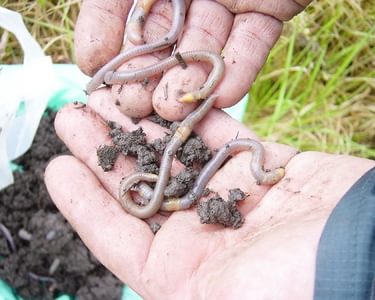Soil
Earthworms

Get to know the earthworm 🔗
Here’s how to get to know the earthworm. Where they live, what they do, and how you can bring them into your plot.
Why are earthworms important?
Worms help create compost. They digest the raw ingredients of a compost heap, break them down, and then secrete a nutrient-rich mix that becomes homemade compost.
Worms are food for the birds. Blackbirds, thrush, and robins will all pull a worm to feed themselves and their growing family. Having plenty of worms in your garden will help support these lovely songbirds, and build up a varied ecosystem in your growing area.
Worms are a natural way of improving the soil. They do this in three ways:
1. Creating good soil structure
Earthworms move through the soil creating burrows. This complex system of tunnels creates pores through which oxygen and water can travel. Different types of earthworms make horizontal and vertical burrows, some of which can be very deep. A soil with plenty of worm burrows won't flash flood.
Worm casts (waste matter) also help to create a fine crumb structure of soil. These casts can contain 5 times more nitrogen, 7 times more phosphorus, and 1000 times more beneficial bacteria than the original soil.
2. Helping decomposition of organic matter
Earthworms play an important role in breaking down organic matter. Their tunnels in the soil are not just a good drainage and ventilation system. They are lined with aerobic bacteria and digested leaf litter, bonded by mucus secreted by the worm. It includes decaying leaves and roots, animal manure, as well as any material found in the compost bin.
Their decomposition releases nutrients and makes them available for use by plants. The worm helps this process by eating the organic matter, breaking it down into smaller pieces, and thus allowing bacteria and fungi to feed on it to release the nutrients.
Earthworms also mix soil layers and incorporate organic matter into the soil. This improves the fertility of the soil, as the organic matter is dispersed and the nutrients become available to bacteria, fungi, and plants.
Charles Darwin was a huge fan of earthworms. When it first came out, his book on them sold more copies than The Origin of the Species!
3. Supporting healthy soil microlife
Where earthworms are present, not only are there more bacteria and fungi – important soil microlife – but they are more active.
These minute life forms release nutrients from organic matter and are an important source of food in their own right for the many other animals that live in soils.
Here are two simple steps to bring worms into your garden
Create your own compost heap. See Home composting
Make sure your soil is full of compost and other organic material for worms to feed on.
More about earthworms ….
There are 27 species of earthworm in the UK. It’s easiest to divide them into three types :
- Anecic earthworms. These are the most common in the UK. They are the largest species, often reddish-brown, and they make permanent vertical burrows in the soil. They feed on leaves on the soil surface that they drag into their burrows. They also cast on the surface (you often see casts in the grass). They make middens (piles of casts) around the entrance to their burrows
- Endogeic earthworms are pale coloured - pink, grey, green or blue - and make horizontal burrows through the soil to move around and to feed. Some can burrow very deeply in the soil.
- Epigeic earthworms don't make burrows, but live on the surface of the soil – often in leaf litter and in compost. These are the worms you often see in your compost heap. They rapidly consume the compost material and they reproduce very quickly. They are usually bright red or reddish-brown, and some are even stripy (known as brandling or tiger worms.)
To help you identify worms in your garden, head over to the Earth Worm Society and see their helpful FAQs Frequently asked questions, including “How do I tell one end of the worm from the other?” and “Why do worms come out after rain?”
By the way, contrary to popular belief, it is not true that cutting a worm in half will result in the regeneration of two separate worms.
Further reading
Earthworm Research
- Do worms help with carbon capture? This article explains how scientists in the US and China discovered that worms, though they release carbon dioxide from the soil into the air, actually capture (sequester) more CO2 than they release.
- Are worms affected by pesticides? In short, yes. Not only can the toxic chemicals increase worm mortality, but also they affect the worms' health, functioning ability, and fertility. See also this research paper which looks at the impact of glyphosate on worms.
- Can earthworms deal with soil contamination? Yes. They combine the metals, such as lead and zinc, with phosphorus or sulphur in special 'compartments' in their cells. This locks the metals into tiny pellets that come out in the worms' poo, thus converting it into an insoluble form that is no longer toxic. Worms that live in highly toxic soils have evolved to accumulate more pollutants in their tissues than those that live in cleaner soils.